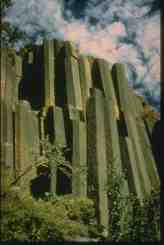| Volcanic Rocks and Features |
 |
Volcanoes have contributed significantly to the formation of the surface of our planet.
Volcanism produced the crust we live on and most of the air we breathe. The remnants
of an eruption reveal as much as the eruption itself, for they tell us many things
about the eruption. Included here are examples of several volcanic products and other
magmatic features, with descriptions of how they were formed and what they tell us
about volcanism. Most volcanic rock material begins as molten rock material formed
within Earth and is called magma. Eruptive products include lava (fluid rockmaterial)
and pyroclastics or tephra (fragmentary solid or liquid rock material). Tephra includes
volcanic ash, lapilli (fragments between 2 and 64 mm), blocks, and bombs. Perhaps
the best known volcanic product is lava, the fluid rock material that flows rather
quietly from volcanic vents. The external and internal structures of lava flows are
the result of the physical properties of the magma from which it was derived. Of these
physical properties viscosity is the most important and it is in turn affected by
the temperature and chemical composition of the magma. Lavas of low viscosity can
spread great distances from the vent. Greater viscosity produces thicker lava flows
that generally cover less area. The rate of supply of magma relative to the velocity
of the lava as it flows from the vent and the external environment through which the
lava flows also affect the structure of the solidified lava. Products of explosive
eruptions include pyroclastic (fire broken) rocks and rock fragments. The force that
produces explosive eruptions is the release of trapped gas. Ejecta from these explosions
may be derived from the magma or from rocks in the vicinity of the volcanic conduit
that are blasted out in the eruption. These may be ejected more or less vertically,
then fall back to earth in the form of ash fall deposits. Pyroclastic flows result
when the eruptive fragments follow the contours of the volcano and surrounding terrain.
They are of three main types: glowing ash clouds (nuee ardente), ash flows, and mudflows.
Volcanic structures can take many forms. A few of the smaller structures built directly
around vents include cinder, spatter, and lava cones. Thick lavas may pile up over
their vents to form lava domes. Larger structures produced by low viscosity lava flows
include lava plains. The erosion of volcanoes leaves volcanic remnants, interesting
reminders of the volcano's former fury. Erosion of the layers of lava and ash that
built the volcano leaves the congealed magma in the conduit. This feature, sometimes
referred to as a plug or the volcanic neck or throat, is a dramatic pillar of rock
rising above the surrounding plain. These plugs or necks may be composed partially
of fragments of the walls of the pipe and partially of congealed magma. They may be
as more than a kilometer in diameter. Magma flowing into cracks in the rocks produces
dikes, sills and laccoliths. This intrusive rock is generally resistant to erosion
and often remains after the surrounding rock has eroded away. These exposed intrusive
rocks give us a glimpse of the complex underground network of piping in active volcanoes.
These igneous features are constant reminders of the timelessness of the processes
that relentlessly form, and reform, the surface of planet Earth. |
|